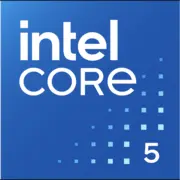Intel Core 5 120U

The Intel Core i5 120U is a powerful and efficient mobile processor that is part of Intel's Raptor Lake series. Built on Intel's 7nm technology, this processor offers impressive performance and energy efficiency for mobile devices.
With 10 total cores and 12 total threads, the Core i5 120U delivers excellent multitasking capabilities, allowing users to run multiple applications simultaneously without any lag or slowdown. Whether you're working on productivity tasks, multimedia editing, or even light gaming, this processor is more than capable of handling the workload.
Additionally, the integrated Intel Graphics ensure smooth and seamless visuals for everyday use and casual gaming. While it may not be as powerful as a dedicated graphics card, it still provides a solid graphics performance for most tasks.
Overall, the Intel Core i5 120U is a great choice for those in need of a reliable and efficient mobile processor. Its combination of strong performance, energy efficiency, and integrated graphics make it a versatile option for a wide range of users. Whether you're a professional on the go or a student in need of a dependable laptop, the Core i5 120U is definitely worth considering.
Basic
Label Name
Intel
Platform
Mobile
Launch Date
January 2024
Model Name
?
The Intel processor number is just one of several factors - along with processor brand, system configurations, and system-level benchmarks - to be considered when choosing the right processor for your computing needs.
120U
Code Name
Raptor Lake
CPU Specifications
Total Cores
?
Cores is a hardware term that describes the number of independent central processing units in a single computing component (die or chip).
10
Total Threads
?
Where applicable, Intel® Hyper-Threading Technology is only available on Performance-cores.
12
Performance-cores
2
Efficient-cores
8
Max Turbo Frequency
?
Max Turbo Frequency is the maximum single-core frequency at which the processor is capable of operating using Intel® Turbo Boost Technology and, if present, Intel® Turbo Boost Max Technology 3.0 and Intel® Thermal Velocity Boost. Frequency is typically measured in gigahertz (GHz), or billion cycles per second.
5 GHz
L3 Cache
12 MB
CPU Socket
?
The socket is the component that provides the mechanical and electrical connections between the processor and motherboard.
FCBGA1744
Technology
?
Lithography refers to the semiconductor technology used to manufacture an integrated circuit, and is reported in nanometer (nm), indicative of the size of features built on the semiconductor.
Intel 7
TDP
15 W
Processor Base Power
?
The time-averaged power dissipation that the processor is validated to not exceed during manufacturing while executing an Intel-specified high complexity workload at Base Frequency and at the junction temperature as specified in the Datasheet for the SKU segment and configuration.
15 W
Maximum Turbo Power
?
The maximum sustained (>1s) power dissipation of the processor as limited by current and/or temperature controls. Instantaneous power may exceed Maximum Turbo Power for short durations (<=10ms). Note: Maximum Turbo Power is configurable by system vendor and can be system specific.
55 W
Max. Operating Temperature
?
Junction Temperature is the maximum temperature allowed at the processor die.
100°C
Memory Specifications
Memory Type
?
Intel® processors come in four different types: Single Channel, Dual Channel, Triple Channel, and Flex Mode. Maximum supported memory speed may be lower when populating multiple DIMMs per channel on products that support multiple memory channels.
Up to DDR5 5200 MT/s Up to DDR4 3200 MT/s Up to LPDDR5/x 6400 MT/s Up to LPDDR4x 4267 MT/s
Max Memory Size
?
Max memory size refers to the maximum memory capacity supported by the processor.
96 GB
Memory Channels
?
The number of memory channels refers to the bandwidth operation for real world application.
2
GPU Specifications
Integrated Graphics Model
?
An integrated GPU refers to the graphics core that is integrated into the CPU processor. Leveraging the processor's powerful computational capabilities and intelligent power efficiency management, it delivers outstanding graphics performance and a smooth application experience at a lower power consumption.
Intel® Graphics
Graphics Frequency
?
Graphics max dynamic frequency refers to the maximum opportunistic graphics render clock frequency (in MHz) that can be supported using Intel® HD Graphics with Dynamic Frequency feature.
1.25 GHz
Miscellaneous
Intel Deep Learning Boost (Intel DL Boost) on CPU
?
A new set of embedded processor technologies designed to accelerate AI deep learning use cases. It extends Intel AVX-512 with a new Vector Neural Network Instruction (VNNI) that significantly increases deep learning inference performance over previous generations.
Yes
Benchmarks
Geekbench 6
Single Core
Score
2275
Geekbench 6
Multi Core
Score
8622
Geekbench 5
Single Core
Score
1869
Geekbench 5
Multi Core
Score
6880
Passmark CPU
Single Core
Score
3912
Passmark CPU
Multi Core
Score
18719
Compared to Other CPU
Geekbench 6 Single Core
Geekbench 6 Multi Core
Geekbench 5 Single Core
Geekbench 5 Multi Core
Passmark CPU Single Core
Passmark CPU Multi Core
Related CPU Comparisons
Share in social media
Or Link To Us
<a href="https://cputronic.com/cpu/intel-core-5-120u" target="_blank">Intel Core 5 120U</a>





